-
Paper Information
- Paper Submission
-
Journal Information
- About This Journal
- Editorial Board
- Current Issue
- Archive
- Author Guidelines
- Contact Us
Resources and Environment
p-ISSN: 2163-2618 e-ISSN: 2163-2634
2016; 6(2): 41-45
doi:10.5923/j.re.20160602.03

The Social and Economical Factors Influence the Use of Cassava for Improving Livelihood in Central African Republic
Kosh-Komba E.1, 2, Aba-Toumnou Lucie1, Zinga I.1, Yandia P.1, Atato A.2, Kadekoy-Tigague D.3, Wabolou F.4, Kongbo Dembo E.4, Batawila K.2, Akpagana K.2
1Laboratory of Biological and Agronomical Sciences for Development, Bangui, Central African Republic
2Laboratory of Botanical and Ecologycal Plant, Faculty of Sciences, University of Lome, Togo
3Central African Republic Institute of Agronomical researches (ICRA), Bangui, Central African Republic
4High Institute of Rural Development, University of Bangui, Central African Republic
Correspondence to: Kosh-Komba E., Laboratory of Biological and Agronomical Sciences for Development, Bangui, Central African Republic.
| Email: |  |
Copyright © 2016 Scientific & Academic Publishing. All Rights Reserved.
This work is licensed under the Creative Commons Attribution International License (CC BY).
http://creativecommons.org/licenses/by/4.0/

Cassava (Manihot esculenta Crantz) is a traditional crop in the food systems in Central African Republic. The objective of this study was to determine the socio-economic and institutional factors that influence the choice of smallholders for use different accessions of Cassava. In total 82 accessions were reported in surveyed sites. In Sibut, more accessions were collected (32 accessions or 39.0%) followed by Yaloké (30 accessions or 36.6%) and (Pissa 20 accessions or 24.4%). The Ancestral Accessions (AA) is the most representative with 39.02%, followed by Accessions Origin Unknown (AOI) with 35.36%. The largest proportion of Cassava planting is the bitter accessions (74, 40%). There are short cycle accessions that are harvested within 10 months (6%); accessions to normal or average cycle can be harvested between 12 to 18 months (49%) and the longest cycle accessions that can be harvested for 2 years and over (45%). The Cassava cycle is one of parts of the selection criteria those producers despite for other selection factors. Farmers’ perception of accessions varied depending on the food habits and the cassava production objective. Some selection criteria considered to be important by farmers at one site were not necessarily important at another site.
Keywords: Farmers, Factors, Choice, Cassava
Cite this paper: Kosh-Komba E., Aba-Toumnou Lucie, Zinga I., Yandia P., Atato A., Kadekoy-Tigague D., Wabolou F., Kongbo Dembo E., Batawila K., Akpagana K., The Social and Economical Factors Influence the Use of Cassava for Improving Livelihood in Central African Republic, Resources and Environment, Vol. 6 No. 2, 2016, pp. 41-45. doi: 10.5923/j.re.20160602.03.
Article Outline
1. Introduction
- Cassava (Manihot esculenta), a starchy root crop, provides food security in much of Africa [1]. Annual African production of 250 million t of Cassava, grown on 6 million ha, comprises 40% of the global production from 55% of the total area under cultivation ([1]; [2]). Cassava provides more than 50% of the caloric requirement for 200 million inhabitants of Africa and for 700 million in the world and is thus an important staple food crop in the tropics [2]. Cassava plant, is one of the most important economically crops in Central African Republic (CAR) and cultivated throughout because it can adapt to the variable soil and climate conditions of the country. This crop is closely associated with food security, as it is consumed in several different ways, and cassava products are obtained from the processing of its flour, or by consumption of its roots. In addition, all parts of the plant, such as leaves, stalks and residue are useful ([3]; [4]; [5]; [6]). The production of cassava has the potential to address pressing challenges of under nutrition and poverty among vulnerable people in rural areas of CAR : (i) cassava production provide essential energy, (ii) cassava production comprise a lucrative market that has great potential for growth (iii) cassava production is an engine for economic growth and generates substantial income per unit area and per person, (iv) cassava production create new income opportunities by value adding activities especially for small producers [7]. Though it is most productive in areas of high rainfall, it also survives drought and locust attacks better than most crops. Hence, its use has increased greatly in dry areas of East and Southern Africa ([8]; [9]). The objective of this study was to determine the socio-economic and institutional factors or practices that influence the choice of smallholders for use Cassava for improving livelihood.
2. Material and Methods
2.1. Choice of Surveyed Sites
- The farm surveys and agronomic trials were carried out in a range of sites in CAR. The sites were chosen to represent a range of environments and management practices in cassava-based cropping systems in the mid-altitude zone of CAR. The farm surveys were carried out in three sites in CAR, which included Sibut, Yaloke and Pissa (figure 1). Main soils in the region include ferric and orthic Acrisols and orthic and haplic Ferralsols; soils that are derived from strongly weathered granite or sedimentary parent material [10]. The climate in all sites is sub-humid with a bimodal rainfall distribution. This allows for the production of most annual crops during both the long (March–August) and the short rains (September–October). Altitude ranges between 1200 and 1500 masl. Cassava is planted in the first 2 months of the short or long rains and remains in the field for about a year. Agricultural systems are diverse with farmers growing 4–6 main crops on average [11].
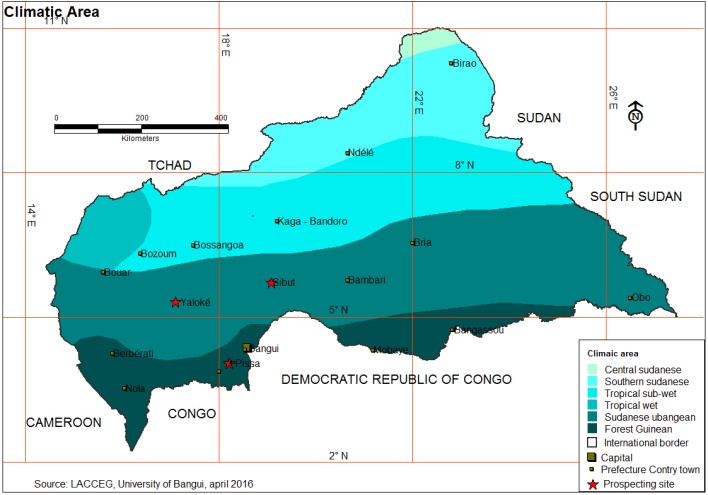 | Figure 1. Location of sites for data collection in Central African Republic |
2.2. Farm Surveys
- A questionnaire was prepared and used as a tool for the collection of information in the different sites. The questionnaire focused on the importance role of choice of the accessions of Cassava for planting. The farm surveys were made over a period of twelve months in the three sites (figure 1). 130- 150 key informants per site ranked all households in three wealth categories; poorer, medium and richer. Twenty households per site were randomly selected, with a minimum representation of three households per wealth category. Structured interviews, in combination with a visit to all fields of each household, were used to collect data on main production constraints, socio-economic settings, farm management, and cassava crop management. Essential information was cross-checked by triangulating interview data with field measurements during a series of field visits. Farmers were asked to estimate average cassava yield in the past few years, by estimating the number of bags of fresh or dry cassava product per unit land. Dry matter yields were converted to t ha_1 fresh cassava yields, using an average dry matter content of 33% ([12]; [13]).
2.3. Statistical Analysis
- Various factors (importance of cassava cultivation for farmers; number of cultivated cassava accessions; origin of cultivated cassava accessions; characters of cultivated cassava accessions; crop cycle of cultivated cassava accessions and disease susceptibility of accessions of cultivated cassava) have been studied. Microsoft Excel 2003 was used to classify different factors.
3. Results and Discussion
3.1. Accessions of Cassava in Surveyed Sites
- 82 accessions were documented in surveyed sites. In Sibut, more accessions were collected (32 accessions or 39.0%) followed by Yaloké (30 accessions or 36.6%) and (Pissa 20 accessions or 24.4%). (Figure 2). The names given to the accessions are mostly in local languages (Banda, Gbaya, Gbakamandja, Peuhl, Mbati, Gbaka, Bofi and Mandja) of ethnic groups who cultivate. They are often linked to anecdotes or events that led to the introduction of cultivars. Some accessions are usually named institutions or people according to the fact of their introduction, this is the case: ICRA and Yaclaire. Several reasons can justify the variation across sites: Ethnic Diversity supporting agricultural practices; the specific ecological conditions in each medium; the exchange of material flows across sites and between communities.
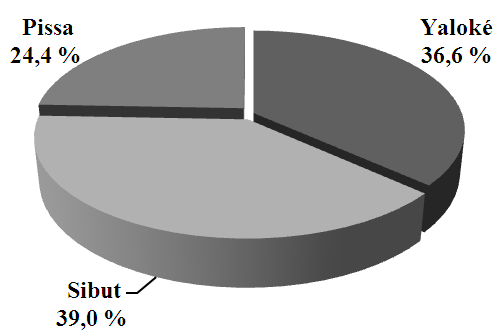 | Figure 2. Different accessions of Cassava in surveyed sites |
3.2. Origin of Accessions of Cassava in Surveyed Sites
- The different proportions of accessions according to their origin are reported in figure 3. The Ancestral Accessions (AA) is the most representative with 39.02%, followed by Accessions Origin Unknown (AOI) with 35.36%. Introduced and Accessions (AI) with 25.6%. The sites of the scale to collections are made up of heterogeneous sources accessions, variously prevalent in the fields of peasant producers through trade flows of materials between producers, population migration and commonalities of government programs and distributions.
 | Figure 3. Distribution of accessions of Cassava in surveyed sites according an origin |
3.3. Origin of Accessions of Cassava in Surveyed Sites
- The largest proportion of Cassava planting is the bitter accessions 74, 40% (figure 4). Overall, producer’s farmers grow more bitter accessions. Most cassava based consumer products resulting from the processing of bitter tubers, which are the main source of income for farmers. The sweet accessions of Cassava are often used at the family level for direct consumption, but less used in trade.
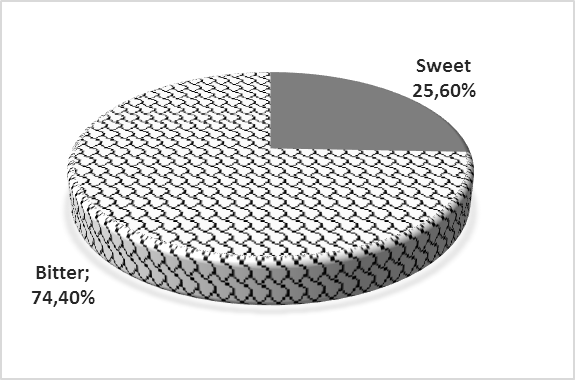 | Figure 4. Proportions of accessions of Cassava in surveyed sites according the taste of tubers |
3.4. Cultural Cycle of Accessions of Cassava in Surveyed Sites
- The Cassava cycle is highly variable for all accessions collected (figure 5). There are short cycle accessions that are harvested within 10 months (6%); accessions to normal or average cycle can be harvested between 12 to 18 months (49%) and the longest cycle accessions that can be harvested for 2 years and over (45%). The Cassava cycle is one of parts of the selection criteria those producers despite for other selection parameters.
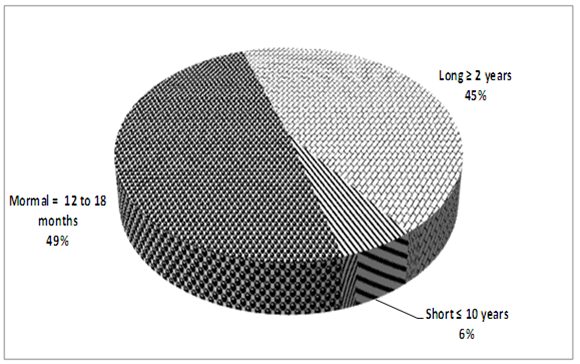 | Figure 5. Cultural cycle of accessions of Cassava in surveyed sites |
3.5. Symptoms Severity Index of Cassava
- 90% of the Cassava accessions have zero Symptoms Severity Index (figure 6).
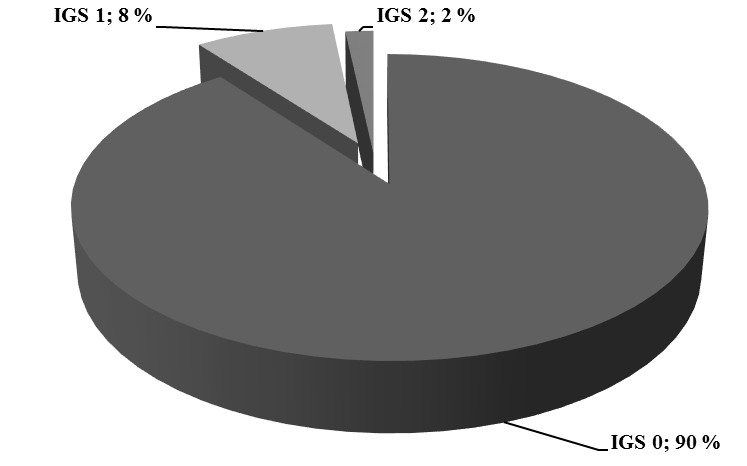 | Figure 6. Symptoms Severity Index of Cassava |
3.6. Discussion
- The objective of this study was to determine the socio-economic and institutional factors that influence the choice of smallholders for use different accessions of Cassava. In total 82 accessions were reported in surveyed sites. In Sibut, more accessions were collected (32 accessions or 39.0%) followed by Yaloké (30 accessions or 36.6%) and (Pissa 20 accessions or 24.4%). The Ancestral Accessions (AA) is the most representative with 39.02%, followed by Accessions Origin Unknown (AOI) with 35.36%. Cassava is generally grown by small farmers, with low technological input in terms of nutrient intake [14]. The constant use of cassava by these traditional communities may be influenced both by propagation and multiplication of the plant; propagation material (stem cuttings) is available for new planting after each crop, and the cassava plant is hardy and adapts to environmental variations ([14]; [15]; [16]).The largest proportion of Cassava planting is the bitter accessions (74, 40%). The abundance of ecotypes bitter tuber within accessions of cultivated cassava in Central Africa ([17]; [18]). Farmers in Africa grow several cassava varieties and over 1 000 local cassava varieties in six counties of the study, namely the Congo, Côte d'lvoire, Ghana, Nigeria, Tanzania and Uganda are identified [19]). The farmers group the local cassava varieties into the bitter and the sweet varieties [20]. The Cassava cycle has an important and decisive impact in the choice of some accessions in CAR cassava producers. There are short cycle accessions that are harvested within 10 months (6%); accessions to normal or average cycle can be harvested between 12 to 18 months (49%) and the longest cycle accessions that can be harvested for 2 years and over (45%). Peasant producers are also much interested in short-cycle accessions for early production. "Six months," for example, is highly regarded for its short cycle and good yield at harvest. In CAR, 36% of accessions are short cycle "Séréka" for example is highly regarded for its short cycle and good yield at harvest [21]. This fact is also proven that it is the accessions that have a long cycle, which give good result [22]. Cassava is, in the case of accessions which the tubers can be stored in the soil, harvested as needed ([23]; [24]). The resistance to mosaic is one of the criteria for choosing among producers. The "Six months" accession has the highest efficiency in collection (average weight of 20 plants 11.2 kg) and zero as an Symptoms Severity Index. This suggests that some accessions unaffected by the Mosaic often have attractive returns and could therefore be tolerant [25]. However similar study reported that the proportion of accessions reached by Mosaic (IGS between 1 and 5) is very important, 72% and the local accession "Bagbogo" which up performance collection (average weight of 12 plants: 18 kg) has a GHI 2 [21]. However, farmers use the following agronomic practices to achieve partial control of the cassava pests and diseases: fallow rotation, crop rotation and selection of the pests and diseases-resistant local varieties. Most of the major cassava pests and diseases are new in Africa as they were introduced only within the last 30 years ([26]; [27]).
4. Conclusions
- Farmers in CAR grow several cassava accessions and many criteria are involved the choice of accessions. The crop cycle of cultivated cassava accessions and the Symptoms Severity Index are more important. The "Six months" accession has the highest efficiency in collection and zero Symptoms Severity Index.
ACKNOWLEDGEMENTS
- This work was funded by grants from the Regional Pole of Applied Research to Development Farming Systems (PRASAC).
 Abstract
Abstract Reference
Reference Full-Text PDF
Full-Text PDF Full-text HTML
Full-text HTML